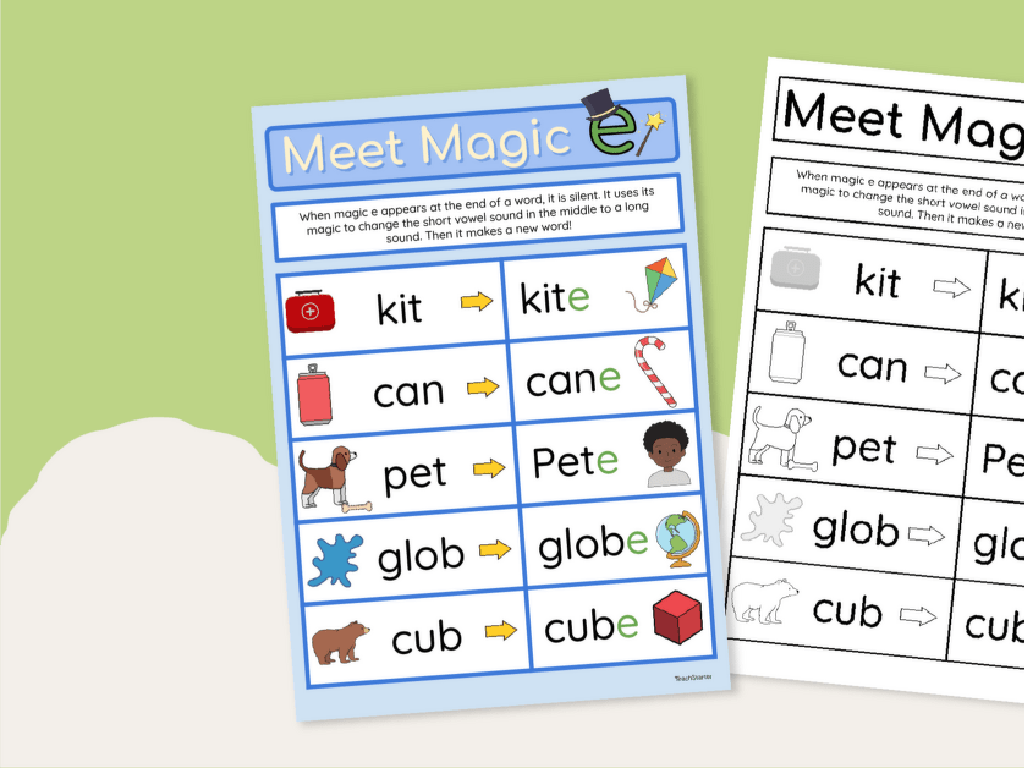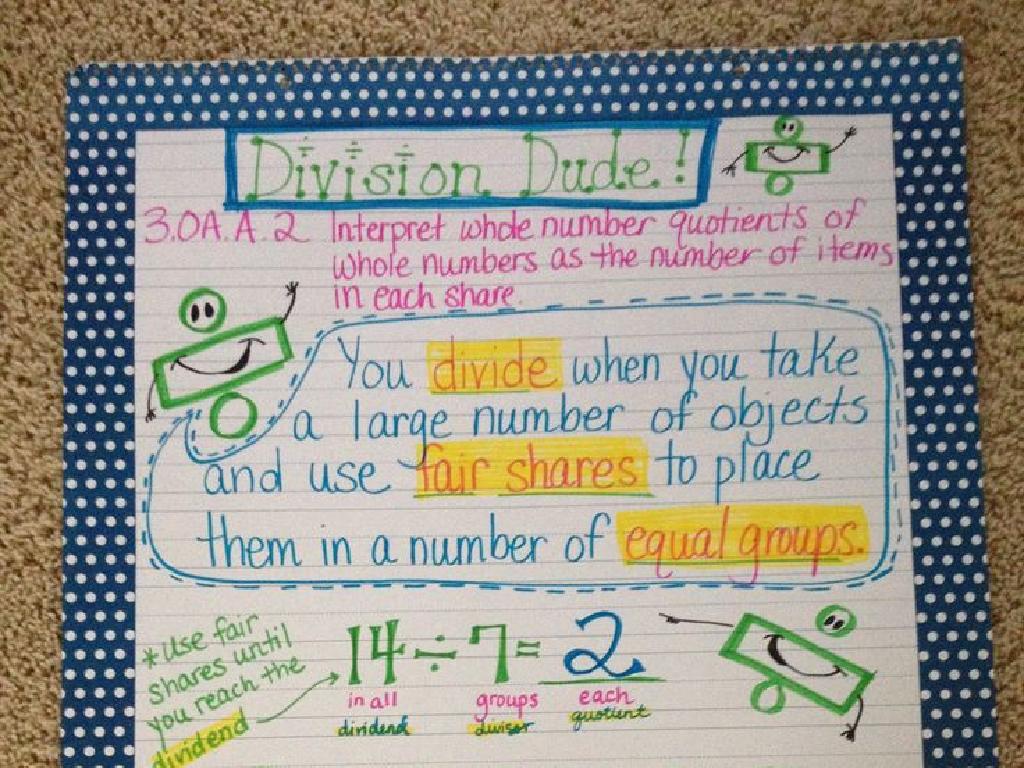Use Models To Subtract A One-Digit Number From A Two-Digit Number - Without Regrouping
Subject: Math
Grade: Second grade
Topic: Subtraction Strategies: Two Digits
Please LOG IN to download the presentation. Access is available to registered users only.
View More Content
Welcome to Subtraction!
– Understanding subtraction
– Subtraction means taking away from a number.
– Subtracting without regrouping
– Keep the tens place the same, only change the ones.
– Example: 52 – 3
– Start with 52, take away 3, and count down to 49.
– Practice with different numbers
|
This slide introduces the concept of subtraction to second graders, emphasizing the process of taking away a smaller number from a larger one without the need to regroup. Begin by explaining that subtraction is like taking some away from what you have. Show them that when we subtract without regrouping, the tens digit stays the same, and we only subtract from the ones place. Use an example like 52 – 3 to illustrate this point. Have the students count backwards from 52 to find the answer. After explaining, provide several examples with different numbers for the students to practice. Encourage them to use physical objects or drawings to visualize the subtraction process.
Understanding Subtraction
– Subtraction means taking away
– It shows how many are left
– Example with apples
– Start with 5 apples, eat 2, then count how many are left.
– Practice with your own items
– Try subtracting items like toys or crayons.
|
This slide introduces the basic concept of subtraction to second graders. Subtraction is explained as the process of taking away from a total amount, which helps us figure out the remaining quantity. Use everyday examples, such as eating apples, to illustrate this point. Encourage students to practice by subtracting items they use daily, like toys or crayons, to reinforce the concept. Make sure to emphasize that no regrouping is needed when subtracting a one-digit number from a two-digit number in this lesson. Provide hands-on activities where students can physically remove items and count what’s left to solidify their understanding.
Subtraction Without Regrouping
– Understand simple take away
– No borrowing needed
– Example: 23 – 5
– Just subtract 5 from 3 in the ones place
– Practice with different numbers
– Try 42 – 6, or 31 – 4 and check with blocks
|
This slide introduces the concept of subtraction without regrouping, which is a foundational skill in second-grade mathematics. Emphasize that this method is straightforward because it does not involve borrowing from the next place value. Use physical objects like blocks or counters to demonstrate the concept visually, which can help students better understand the process. Provide several examples for the students to practice, such as 42 – 6 or 31 – 4, and encourage them to use models to represent the numbers and perform the subtraction. This hands-on activity will reinforce their understanding of the concept.
Using Models to Subtract Without Regrouping
– Models visualize subtraction
– Use blocks or drawings
– Objects like blocks represent numbers
– Example with base-ten blocks
– Subtract 1 block from 23 blocks
– Practice subtracting together
– Let’s solve a few problems as a class
|
This slide introduces the concept of using physical models or drawings to help second-grade students understand subtraction without regrouping. Start by explaining that models are a way to see and understand what subtraction looks like. Demonstrate how to use base-ten blocks to represent the numbers in a subtraction problem. For example, if we have 23 blocks and we take away 1 block, we can easily see that we have 22 blocks left. Encourage students to use these models to visualize the subtraction process. Plan a class activity where students can practice this concept by subtracting different one-digit numbers from two-digit numbers using base-ten blocks or drawings. This hands-on experience will help solidify their understanding of subtraction without regrouping.
Let’s Practice Together: Subtracting Without Regrouping
– Start with the number 34
– Break it into tens and ones
– 34 has 3 tens (30) and 4 ones
– Subtract 6 ones from 4 ones
– Since 4 is less than 6, we subtract 6 from 14 (10 + 4)
– Final answer after subtraction
– The result is 28 because 30 stays the same and 4 becomes 8 after subtraction
|
This slide is a class activity to practice subtraction without regrouping. Start by explaining that 34 consists of 3 tens and 4 ones. Highlight that we only subtract from the ones place, and if the ones are not enough, we think of the tens as 10 ones added to the actual ones. For example, 34 is 30 (or 3 tens) and 4 ones. If we need to subtract 6, we consider it as subtracting from 14 (10 from the tens plus 4 ones). After subtracting, we combine the unchanged tens with the new ones value to get the final answer. Activities for students can include using physical blocks to represent tens and ones, drawing the numbers, or using a number line. Encourage students to explain their thought process as they subtract.
Your Turn to Try: Subtracting with Models!
– Time to subtract using models
– No need to regroup, keep it simple
– Let’s try 42 minus 7 together
– Subtract 7 ones from 42 without borrowing
– Use base-ten blocks or draw it out
– Draw 4 tens and 2 ones, then cross out 7 ones
|
This slide is an interactive activity for students to practice subtraction using visual aids. Encourage the students to use base-ten blocks or drawings to represent the numbers. For 42, they should draw 4 tens (or use 4 ten-blocks) and 2 ones (or 2 one-blocks). Then, they need to remove 7 ones. Since there are not enough ones, they should understand that no regrouping is necessary because the number being subtracted is less than the number of ones available. This exercise will help solidify their understanding of subtraction without regrouping. Possible variations of the activity could include using different numbers or incorporating real-life scenarios where they might need to subtract smaller quantities from larger ones.
Class Activity: Subtraction Bingo
– Play Bingo with subtraction problems
– Solve problems to mark your Bingo card
– Use subtraction skills to find the answers
– Aim for five correct in a row
– Get ready for a subtraction victory!
– Who will be the subtraction champion?
|
This interactive class activity is designed to make learning subtraction fun through a game of Bingo. Each student will receive a Bingo card with different subtraction problems involving a one-digit number subtracted from a two-digit number without regrouping. As the teacher calls out problems, students will solve them and mark their cards if they have the correct answer. The goal is to get five correct answers in a row, horizontally, vertically, or diagonally. Prepare several sets of problems to ensure a dynamic game. Possible variations of the activity could include team play, timed rounds, or a larger Bingo grid for extended play. This game encourages mental math practice and reinforces the concept of subtraction without regrouping.
Subtraction Success: No Regrouping Needed!
– Congratulations on learning subtraction!
– Practice with models to improve
– Use objects like blocks or drawings to subtract
– Remember your homework worksheet
– Complete the worksheet to practice what you’ve learned
– Keep practicing and have fun!
|
This slide is a celebratory conclusion to the lesson on subtracting a one-digit number from a two-digit number without regrouping. Reinforce the students’ confidence by praising their efforts and encourage them to continue practicing with models such as base-ten blocks, counters, or drawings to visualize the subtraction process. Remind them of the importance of completing their homework worksheet to reinforce the day’s learning. The worksheet should include a variety of subtraction problems that apply the concept taught. Offer additional practice opportunities for students who may need more support and encourage them to approach subtraction with a positive and playful attitude.






